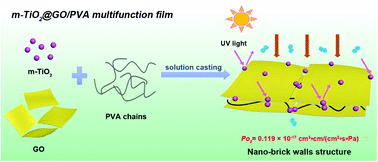Multifunctional films with a highly oriented “nano-brick wall” structure by regulating modified TiO2@graphene oxide/poly(vinyl alcohol) nanocomposites†
Abstract
High-performance packaging materials featuring a superior gas barrier and UV resistance as well as excellent mechanical properties are highly desirable but are still encountering serious challenges in the food, pharmaceutical and electronic industries. Here, a multifunctional film based on a modified titanium dioxide@graphene oxide/poly(vinyl alcohol) (TiO2@GO/PVA) nanocomposite with a multilayer nano-brick wall structure is rationally designed and fabricated by a facile solution casting approach. The modified TiO2 nanoparticles, assembled on the surface and edges of GO, are employed as bridges to construct the GO edge-to-edge alignment. Then, they tightly combine with PVA chains, acting as the mortar, to form a multilayer compact film. Therefore, the oxygen permeability of the nanocomposite film decreases to 0.119 × 10−17 cm3·cm (cm2·s·Pa)−1 with the addition of 1.0 wt% GO and 1.2 wt% modified TiO2, reduced by 93% compared with pure PVA film. More impressively, it is increased by only 5.9% after 9 h of ultraviolet light irradiation, which shows its exceptional UV resistance ability. In addition, the mechanical performance, thermal stability and water resistance are substantially improved. The developed modified TiO2@GO/PVA nanocomposite films with outstanding performance can be perceived as a green biodegradable material for a wide range of packaging industries.



 Please wait while we load your content...
Please wait while we load your content...